The Hidden Gem of Kom Ombo Temple: A Must-See for History Buffs
If you are fascinated by ancient civilizations and the secrets they hold, you are in for a treat.
Nestled within the heart of Kom Ombo, Egypt, lies a hidden gem that will transport you back in time: the Kom Ombo Temple. Built during the Greco-Roman era, this temple boasts intricate carvings and impressive architecture, showcasing the remarkable skill of the ancient Egyptian builders.
Exploring the temple's walls and corridors will uncover intriguing tales and myths preserved for centuries so, if you are a history buff, but the Kom Ombo Temple on your bucket list. You won't want to miss out on this unforgettable experience.

A brief overview of Kom Ombo Temple
Welcome to the captivating world of Kom Ombo Temple, a hidden gem that awaits history buffs like yourself. Situated on the banks of the majestic Nile River, this temple offers a unique glimpse into the ancient Egyptian civilization. Let's start with a brief overview:
• Kom Ombo Temple is an extraordinary archaeological marvel located in Upper Egypt.
• It is renowned for being a double temple dedicated to two sets of gods - Sobek, the crocodile god, and Horus, the sky god.
• Built during the Ptolemaic dynasty, it showcases exquisite architecture and fascinating inscriptions.• The temple's strategic location offers picturesque views of the Nile River, adding to its allure.
Now that you have a glimpse of what awaits at Kom Ombo Temple let's delve deeper into its historical significance, construction during the Ptolemaic era, and the remarkable inscriptions and reliefs that depict ancient practices and medical knowledge. Prepare to be mesmerized by this ancient treasure!
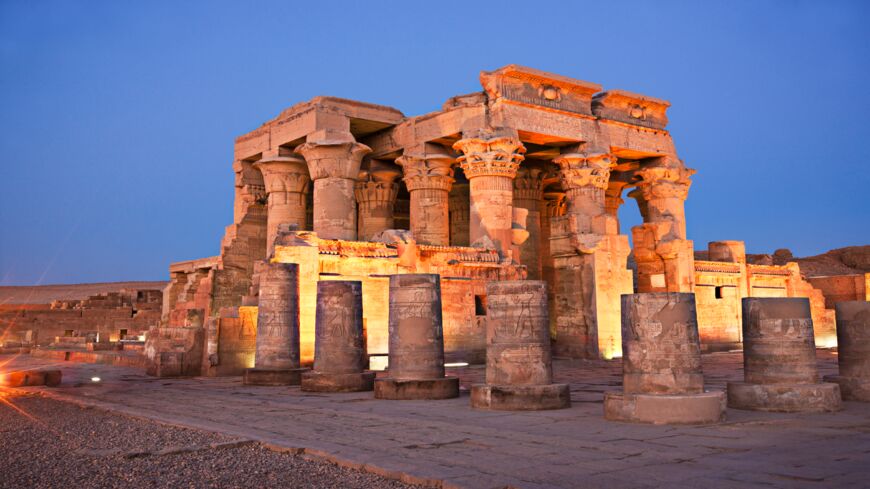
Importance of the temple in Ancient Egypt
The Kom Ombo Temple holds immense significance in ancient Egyptian history, making it a must-see attraction for any history buff. Here are some key reasons why this temple is so important:
- Historical Significance: The temple was built during the Ptolemaic dynasty, a period of strong Hellenistic influence in Egypt. It served as a crucial religious and cultural centre during this time.
- Architectural Marvel: The temple boasts impressive architectural features, showcasing the mastery of ancient Egyptian craftsmanship. From its towering columns adorned with intricate carvings to its well-preserved courtyard, every inch of the temple is a feast for the eyes.
- Religious Practices: The temple's inscriptions and reliefs provide valuable insights into ancient Egyptian religious practices and medical knowledge. They depict various rituals, beliefs, and even surgical instruments, offering a glimpse into the daily life of ancient Egyptians.
- Dual Dedication: One of the unique aspects of the Kom Ombo Temple is its dual dedication to two sets of gods—Sobek, the crocodile god, and Horus, the sky god. The temple's design and layout reflect these deities' important roles in Egyptian mythology and their association with power and the Pharaoh.
Visiting the Kom Ombo Temple is not just a chance to marvel at its beauty but also an opportunity to dive deep into the rich tapestry of ancient Egyptian history and culture.

History of Kom Ombo Temple
Construction during the Ptolemaic dynasty
The construction of the Kom Ombo Temple dates back to the Ptolemaic dynasty, when Greek pharaohs ruled ancient Egypt. This temple is located in Aswan, Egypt, and is believed to have been built between the 2nd and 1st centuries BCE.
The Ptolemies significantly enhanced the temple, adding impressive structures and intricate details. Some notable features include the beautiful inscriptions and reliefs that can be found throughout the temple, depicting ancient practices and medical knowledge. These carvings provide valuable insights into the beliefs and traditions of the time.
The construction during the Ptolemaic dynasty showcases the architectural and artistic achievements of the era, making it a fascinating aspect to explore when visiting the Kom Ombo Temple.
:max_bytes(150000):strip_icc()/GettyImages-157675568-5c3ee84246e0fb00016e5151.jpg)
Enhancements made by various Ptolemies
The Kom Ombo Temple, known as the hidden gem of ancient Egypt, holds a fascinating history that attracts history buffs worldwide. One of the most intriguing aspects of the temple is the enhancements made by various Ptolemies, the ruling dynasty, during its construction. These enhancements not only added to the temple's grandeur but also reflected the religious and cultural beliefs of the time. Here are some noteworthy enhancements made by the Ptolemies:
- Expansion of the temple complex: The Ptolemies extended the existing structure and added new buildings, including a larger sanctuary and additional ritual halls.
- Elaborate carvings and reliefs: The Ptolemies adorned the temple with intricate carvings and detailed reliefs depicting various scenes from Egyptian mythology, royal rituals, and daily life in ancient Egypt.
- Offerings and rituals: The Ptolemies introduced new offerings and rituals to honour the gods. These included elaborate ceremonies, processions, and the provision of various goods to the deities.
- Development of the outer temple: Alongside the main temple, the Ptolemies also developed the outer temple, comprising vast courtyards, a sacred lake, and smaller sanctuaries dedicated to other gods.
The enhancements made by the Ptolemies at the Kom Ombo Temple showcase their commitment to maintaining and expanding religious institutions and preserving ancient Egyptian traditions. Visitors can marvel at these architectural marvels and intricate carvings, immersing themselves in ancient Egypt's rich history and culture.
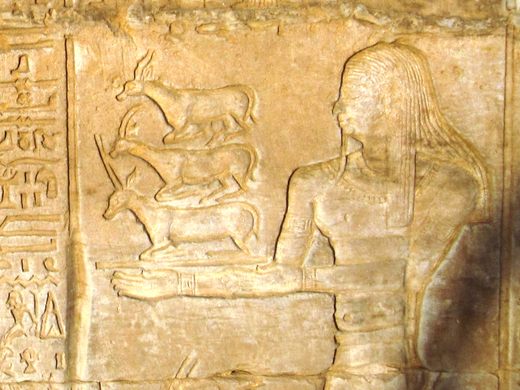
Inscriptions and reliefs depicting ancient practices and medical knowledge
As you explore the fascinating Kom Ombo Temple, you will find inscriptions and reliefs that offer a captivating glimpse into ancient practices and medical knowledge. These ancient depictions provide valuable insights into the medical advancements of the time and shed light on the practices of healers and priests.
Some of the inscriptions reveal surgical tools and techniques, demonstrating the remarkable surgical expertise of ancient Egyptians. The reliefs showcase various medical scenes, including examining patients, preparing medicines, and even surgical procedures. These depictions serve as a testament to the remarkable medical knowledge of ancient Egyptians.
It is truly remarkable to witness these intricate carvings and feel a sense of awe at the advanced medical practices of the past.
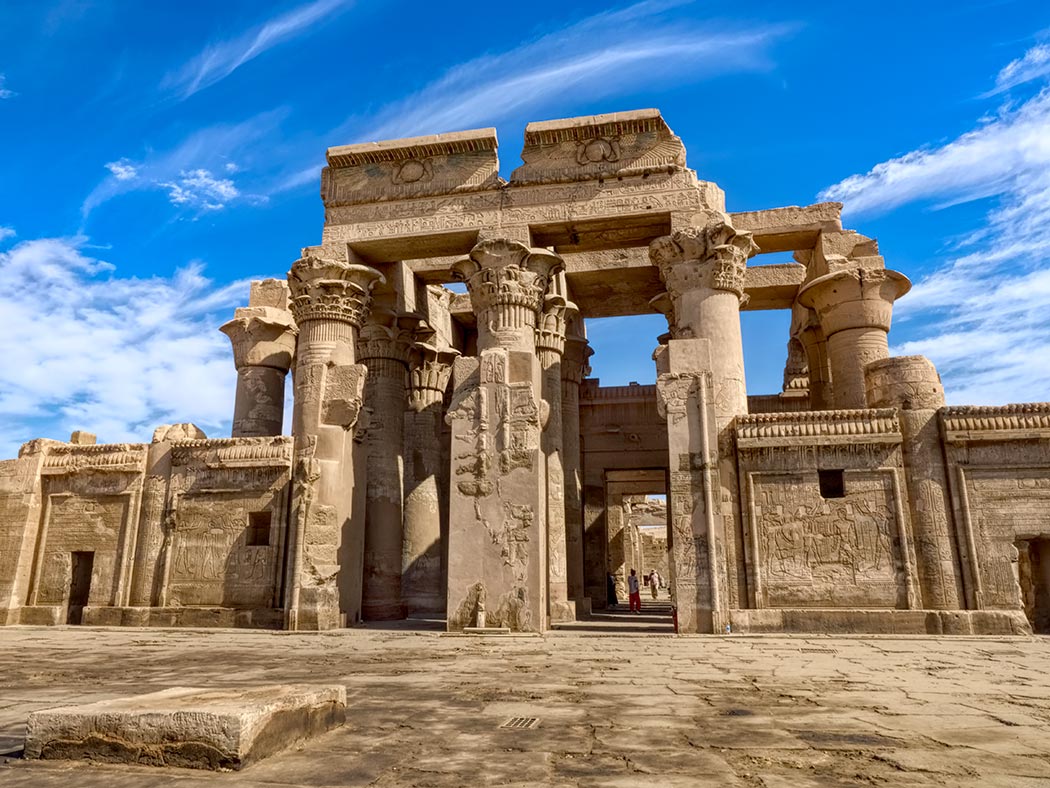
Unique Features of Kom Ombo Temple
Double dedication to two sets of gods: Sobek and Horus
As you explore the magnificent Kom Ombo Temple, one of its most fascinating aspects is its double dedication to two sets of gods: Sobek and Horus. This unique feature sets it apart from ancient Egyptian temples and adds to its allure for history buffs like yourself.
• Sobek, the crocodile god, was highly revered in ancient Egypt. He was associated with the mighty Nile River and its ferocious inhabitants and was believed to have the power to protect and ensure fertility.
• Horus, on the other hand, was the sky god and often depicted as a falcon. He was closely connected to the pharaohs and symbolized kingship and divine authority. The double aspect of the temple reflects the importance of both Sobek and Horus in the religious and cultural beliefs of ancient Egyptians. As you delve into the intricacies of the temple's architecture and explore the stunning carvings depicting these deities, you'll gain a deeper appreciation for their significance in ancient Egyptian history.
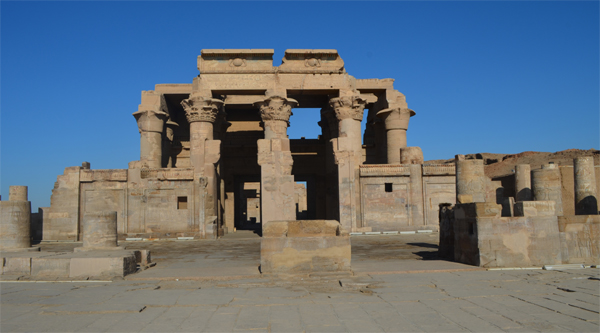
Significance of Sobek as the crocodile god
One of the most intriguing aspects of the Kom Ombo Temple is the significance of Sobek, the crocodile god. Sobek was a major figure in ancient Egyptian mythology and was worshipped as the god of fertility, protection, and power. Here are some key points to understand the significance of Sobek:
- Sobek was often depicted as a man with the head of a crocodile, symbolizing his connection to the Nile and its abundant resources.
- The crocodile was revered as a sacred animal, and temples dedicated to Sobek were constructed in areas known for their crocodile populations.
- Sobek was believed to possess a range of powers, including warding off evil spirits and bringing good fortune to the kingdom.
- The ancient Egyptians associated crocodiles with the Pharaoh's power, as they were believed to be manifestations of Sobek himself.
- Sobek's presence in the Kom Ombo Temple is evident in various inscriptions and reliefs that depict the god and his association with the Nile and fertility.
Visiting the Kom Ombo Temple provides a unique opportunity to delve into the fascinating mythology of ancient Egypt and appreciate the significance of Sobek as the crocodile god.
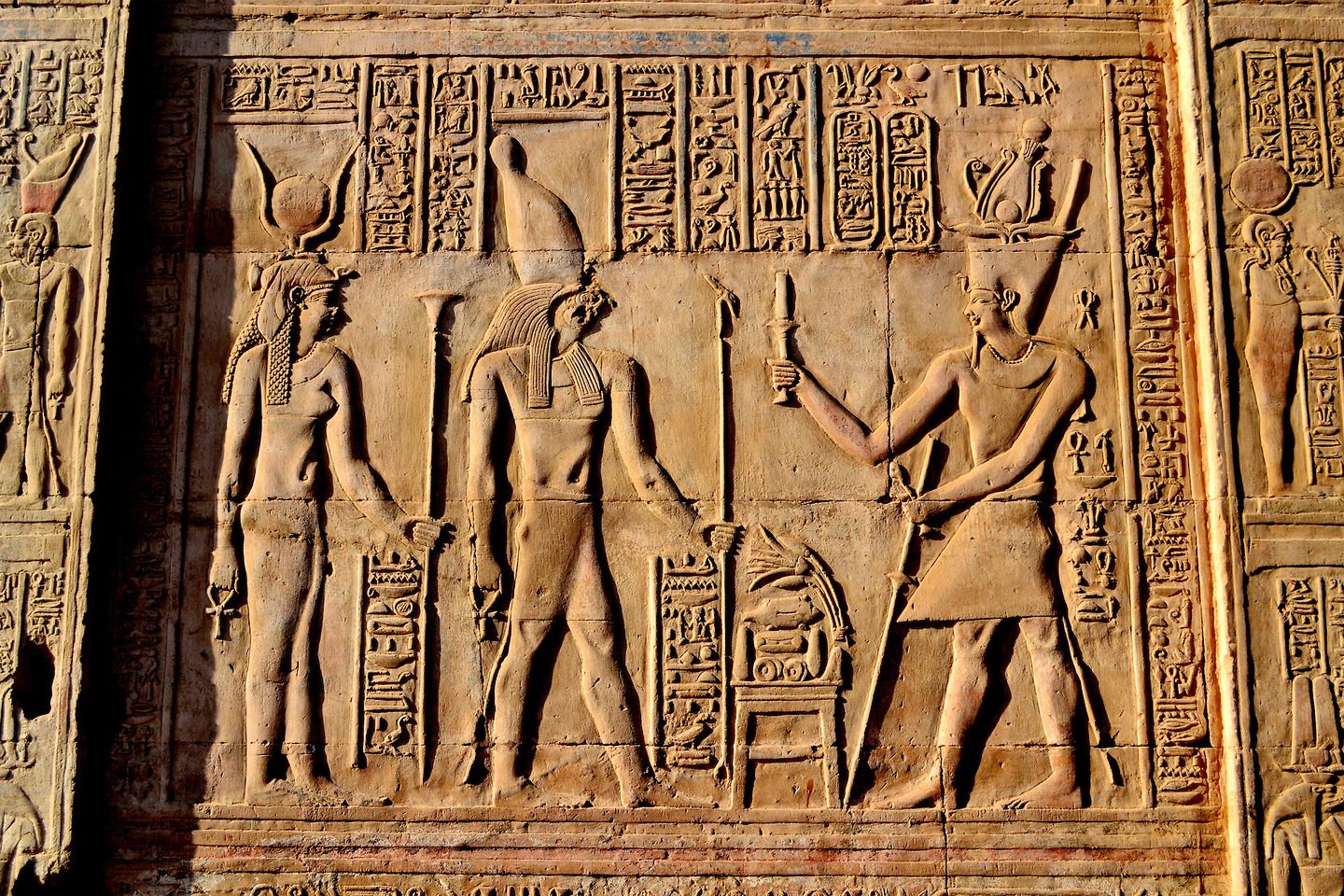
Role of Horus as the sky god and its association with the Pharaoh
When exploring the fascinating Kom Ombo Temple, one cannot overlook the role of Horus, the sky god, and its association with the Pharaoh. Here are some fascinating insights about this connection:
- Horus was revered as the son of the goddess Isis and the sky god Osiris, symbolising the pharaoh's divine lineage and authority.
- The Pharaoh was believed to be the living embodiment of Horus on Earth, acting as the intermediary between the gods and the people.
- Horus' iconic eye, known as the Eye of Horus, symbolized protection, good health, and royal power. It was often depicted on ancient Egyptian amulets and temple reliefs.
- The Pharaoh's role as the representative of Horus meant that he was responsible for maintaining cosmic order and ensuring the prosperity and well-being of the kingdom.
- The connection between Horus and the Pharaoh can be seen in the temple's architectural layout, where the two main sanctuaries dedicated to Sobek and Horus are positioned side by side, symbolizing their equal importance.
So, when visiting Kom Ombo Temple, take a moment to appreciate the role of Horus as the sky god and its close association with the Pharaoh, which played a crucial part in ancient Egyptian society and religious beliefs.
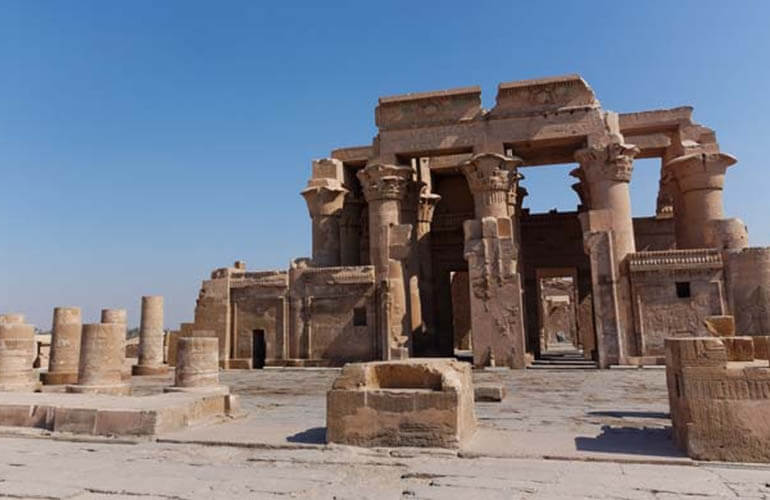
Step-by-Step Guide to Visiting Kom Ombo Temple
Arrival at the temple and views of the Nile River
As you arrive at the Kom Ombo Temple, you'll be immediately captivated by the breathtaking views of the majestic Nile River. Standing on the banks of this iconic river, you'll feel a sense of awe and wonder as you take in the tranquil surroundings.
The temple is situated on a slight elevation, providing a stunning panorama of the Nile. The glistening waters, lush greenery, and gentle breeze create a serene atmosphere perfect for exploration and contemplation.
Whether you visit during sunrise or sunset, the views are equally enchanting, with the sun casting its golden hues on the river's surface. It's a truly picturesque scene that will leave you feeling connected to Egypt's rich history and natural beauty.

Exploration of the courtyard and columns adorned with carvings
As you embark on your journey through Kom Ombo Temple, you will find yourself captivated by the wonders of its courtyard and the intricately carved columns that adorn it.
The courtyard, with its open space and stunning views of the Nile River, provides a sense of tranquillity that transports you back to ancient times. As you stroll through the courtyard, take a moment to appreciate the impressive carvings that depict scenes from Egyptian mythology and everyday life.
The attention to detail in these carvings is truly remarkable, showcasing the ancient craftsmanship and artistic skill of the time. Each column tells a unique story, reflecting ancient Egypt's rich history and culture. You could spend hours exploring the courtyard, immersing yourself in the beauty and symbolism of these remarkable carvings.

Entrance into the double temples of Sobek and Horus
As you step into the Kom Ombo Temple, you will be greeted by a sight of awe-inspiring beauty. The entrance leads you into the mesmerizing double temples dedicated to Sobek and Horus. The intricate carvings on the walls and columns will catch your eye, depicting ancient stories and practices.
The double temples provide a unique experience, allowing you to explore the different sanctuaries of these two powerful gods. Take your time to admire the remarkable craftsmanship and attention to detail in these sanctuaries, as they offer a fascinating glimpse into ancient Egyptian beliefs.
As you wander through the temple, you will feel a sense of reverence and wonder, realizing the immense importance of this sacred site in ancient times.
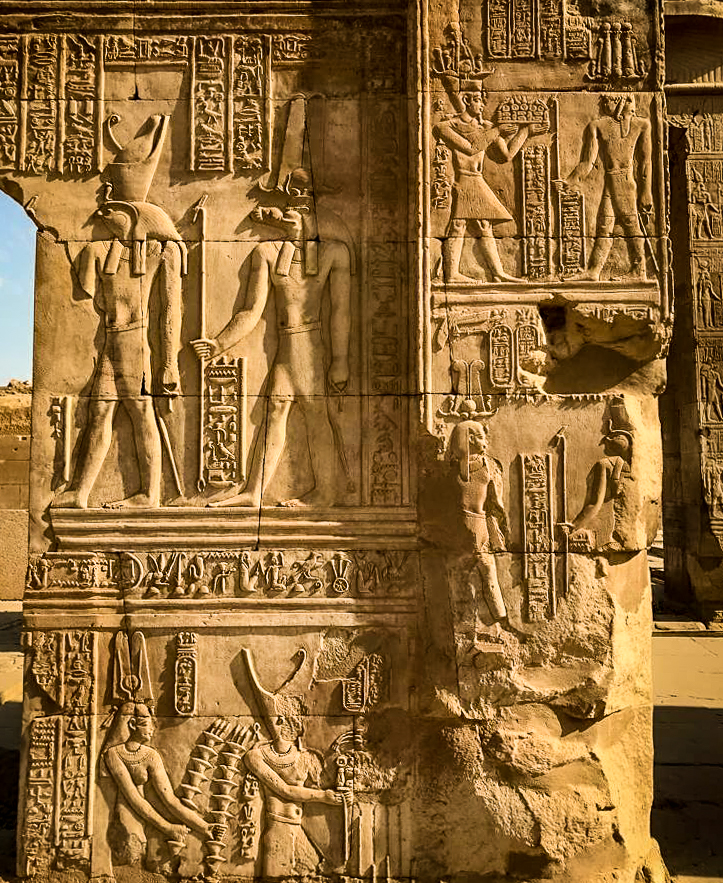
Importance of Crocodile Worship in Ancient Egypt
Revere for crocodiles as sacred animals.
As you delve into the rich history of Kom Ombo Temple, one of the most intriguing aspects you'll encounter is the reverence for crocodiles as sacred animals. In ancient Egypt, crocodiles were considered powerful creatures, embodying the strength and ferocity of the crocodile god, Sobek. The connection between Sobek and crocodiles led to an association with the pharaoh's power, as the ruler was believed to possess similar qualities.
The importance of crocodiles is evident in the temple's design and artwork. Intricate carvings and inscriptions depict crocodiles in various contexts, showcasing their status as divine beings. At the temple, even mummified crocodiles are displayed, further emphasizing the significance of these animals in ancient Egyptian culture. This deep reverence for crocodiles as sacred creatures offer a fascinating glimpse into the beliefs and practices of this ancient civilization.
:max_bytes(150000):strip_icc()/GettyImages-157675568-5c3ee84246e0fb00016e5151.jpg)
Belief in their connection to Sobek and Pharaoh's power
The connection between crocodiles, Sobek, and the Pharaoh in ancient Egypt was a significant belief that shaped the culture and power dynamics of the time. Here are some key points to explore this belief further:
- Crocodiles were considered sacred animals and were revered for their strength and ferocity. Ancient Egyptians believed that Sobek, the crocodile god, possessed these qualities and bestowed them upon the Pharaoh.
- The Pharaoh, seen as the earthly embodiment of Horus, the sky god, held immense power and authority. The association between Sobek and the Pharaoh reinforced this perception of the ruler's strength and divine connection.
- The Nile River, where crocodiles resided, was seen as a symbol of fertility and life. Connecting the Pharaoh to the sacred crocodile emphasized the ruler's role in ensuring abundance and prosperity for the land.
- Depictions and inscriptions in Kom Ombo Temple showcase crocodiles' veneration and connection to Sobek. Visitors can witness the reverence given to these powerful creatures, further highlighting their association with the Pharaoh's power.
Overall, the belief in the connection between crocodiles, Sobek, and the Pharaoh provided a spiritual and symbolic foundation for the authority and status of the ancient Egyptian rulers.
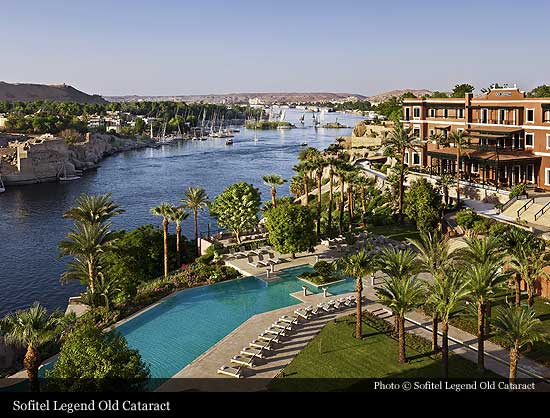
Accommodation Options near Kom Ombo Temple
Luxurious stays like Sofitel Legend Old Cataract Aswan
If you're looking for a luxurious stay near the Kom Ombo Temple, the Sofitel Legend Old Cataract Aswan is an excellent choice.
This iconic hotel offers breathtaking views of the Nile River and unmatched opulence. With its colonial charm and exquisite décor, you'll feel like royalty during your stay.
The hotel boasts a range of amenities, including a swimming pool, spa, and multiple dining options. Indulge in a gourmet meal at the renowned 1902 Restaurant, where you can savour delicious dishes while enjoying panoramic views.
The attentive staff will ensure that your every need is met, making your stay truly unforgettable.
Consider the Sofitel Legend Old Cataract Aswan for a luxurious and indulgent experience near the historical Kom Ombo Temple.

Mid-range options like Mövenpick Resort on Elephantine Island
If you're looking for a comfortable and convenient place to stay near Kom Ombo Temple, Mövenpick Resort on Elephantine Island is a mid-range option that offers a delightful experience.
This beautiful resort is located on an island in the middle of the Nile River, providing breathtaking views of the surrounding landscapes. With its well-appointed rooms and modern amenities, Mövenpick Resort offers a comfortable and relaxing stay for guests.
The resort also features a range of facilities, including a swimming pool, spa, and fitness centre, ensuring you have everything you need for an enjoyable stay. Additionally, the on-site restaurants and bars provide delicious dining options, allowing you to enjoy a satisfying meal after exploring the temple.
Overall, Mövenpick Resort on Elephantine Island is a fantastic mid-range choice for accommodation near Kom Ombo Temple, offering both comfort and convenience.

Budget-friendly choices such as Nubian Oasis Hotel
If you're planning a visit to Kom Ombo Temple and are on a budget, the Nubian Oasis Hotel is an excellent choice for accommodation. This budget-friendly hotel offers comfortable rooms at affordable rates, allowing travellers to save money without compromising on quality. Located near the temple, it provides easy access to all the ancient wonders and breathtaking views of the Nile River. The hotel staff are friendly and welcoming, ensuring a pleasant stay for guests. The Nubian Oasis Hotel also offers free Wi-Fi and a restaurant where you can enjoy delicious local cuisine. With its convenient location and affordable prices, this hotel is the perfect option for budget-conscious travellers exploring the hidden gem of Kom Ombo Temple.

Dining Options in Aswan
Fine dining at 1902 Restaurant in Sofitel Legend Old Cataract Aswan
Regarding fine dining in Aswan, the 1902 Restaurant in the Sofitel Legend Old Cataract is an absolute must-visit.
Nestled within the historic hotel, this restaurant offers a culinary experience. Immerse yourself in the exquisite ambience as you dine on delectable dishes inspired by Egyptian and international flavours.
The menu features various options, from succulent seafood to perfectly cooked steaks, all expertly prepared and beautifully presented. Whether you're celebrating a special occasion or simply looking for an unforgettable dining experience, the 1902 Restaurant promises to deliver.
Relax and unwind as you indulge in culinary delights and savour the panoramic views of the Nile River from the restaurant's terrace. With impeccable service, a charming atmosphere, and world-class cuisine, the 1902 Restaurant is an absolute gem for food enthusiasts visiting Aswan.
:max_bytes(150000):strip_icc()/GettyImages-157675568-5c3ee84246e0fb00016e5151.jpg)
Mid-range experience at Panorama Restaurant and Bar at Movenpick Resort
When enjoying a mid-range dining experience near the Kom Ombo Temple, look no further than the Panorama Restaurant and Bar at Movenpick Resort. This restaurant offers a delightful combination of delicious food and breathtaking views.
• You will be mesmerized by the panoramic vistas of the Nile River, which create a stunning backdrop for your meal.
• The restaurant's ambience is warm and inviting, with a relaxed atmosphere perfect for unwinding after exploring the temple.
• The menu at Panorama Restaurant showcases a variety of Egyptian and international dishes prepared with the freshest ingredients and flavorful spices.• One of the must-try dishes is the traditional Egyptian grilled chicken, known as "taouk," which is cooked to perfection and bursting with flavour.• The restaurant also offers a range of vegetarian options, ensuring everyone can find something to suit their palate.• To complement your meal, the bar offers a selection of refreshing cocktails and beverages, perfect for sipping as you take in the breathtaking views.• The attentive and friendly staff at Panorama Restaurant ensures that your dining experience is enjoyable and memorable.• The prices at this mid-range restaurant are reasonable, allowing you to indulge in a delicious meal without breaking the bank.
Whether you're looking for a relaxing lunch or a romantic dinner, Panorama Restaurant and Bar at Movenpick Resort is the perfect spot to enjoy a memorable dining experience near the Kom Ombo Temple.

Budget-friendly local food at El Dokka
When visiting the Kom Ombo Temple, your exploration will likely improve your appetite. If you're looking for a budget-friendly meal option, look no further than El Dokka. This local food spot offers a delightful experience without breaking the bank.
Here, you'll have the opportunity to savour traditional Egyptian dishes bursting with flavours that will transport you to the heart of this ancient land. From aromatic koshary, a popular Egyptian street food made with rice, lentils, and pasta, to tantalizing falafel served with fresh salads and warm pita bread, El Dokka has something to satisfy every palate.
With its friendly atmosphere and affordable prices, dining at El Dokka is the perfect way to end your day of exploration at Kom Ombo Temple. So, sit back, relax, and indulge in the delicious flavours of Egypt without emptying your wallet.
